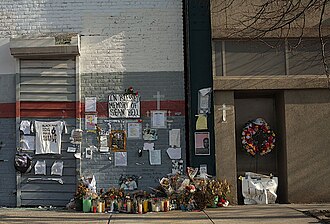Crime in New York City





Crime in New York City has been recorded since the founding of the city in the 17th century. The city has experienced a varied history of crime, influenced by its development, economic changes, and social tensions. Over the years, New York City has seen fluctuations in crime rates, with significant decreases in the late 20th and early 21st centuries.
History[edit]
The history of crime in New York City can be divided into several periods, marked by the dominant types of crime and the social and economic conditions of the times. In the 19th century, the city saw the rise of organized crime groups, including the Five Points Gang and the Italian Mafia. The Prohibition era of the 1920s led to a surge in bootlegging, speakeasies, and gang violence.
The 1970s and 1980s were characterized by high rates of violent crime, including murder, robbery, and assault. The crack cocaine epidemic of the 1980s further exacerbated the situation, leading to an all-time high in crime rates by the early 1990s.
Decline in Crime[edit]
Starting in the mid-1990s, New York City experienced a dramatic decline in crime, attributed to various factors including improved policing tactics, such as the CompStat system, and socioeconomic improvements. The introduction of the "broken windows" policing strategy, which aimed to reduce minor crimes to prevent more serious ones, also played a role. By the 2000s, New York City had become one of the safest large cities in the United States.
Current Trends[edit]
In recent years, New York City has seen a fluctuation in crime rates, with a notable increase in certain types of crime, such as cybercrime and hate crimes, reflecting broader national trends. However, traditional violent crimes and property crimes have continued to decrease overall.
Types of Crime[edit]
New York City experiences a range of criminal activities, including but not limited to:
- Violent crime: including murder, rape, robbery, and assault.
- Property crime: including burglary, larceny-theft, motor vehicle theft, and arson.
- Cybercrime: including identity theft, hacking, and online fraud.
- Hate crimes: crimes motivated by bias against race, religion, sexual orientation, or ethnicity.
Policing and Law Enforcement[edit]
The primary agency responsible for law enforcement in New York City is the New York City Police Department (NYPD), one of the oldest and largest police departments in the world. The NYPD employs a variety of strategies and technologies to combat crime, including community policing, surveillance systems, and data analytics.
Challenges and Criticisms[edit]
The efforts to reduce crime in New York City have not been without controversy. Critics argue that strategies like "stop and frisk" and "broken windows" policing have led to racial profiling and the over-policing of minority communities. The city continues to grapple with finding a balance between effective crime reduction and protecting civil liberties.
See Also[edit]
- History of New York City
- New York City Police Department
- Organized crime in New York
- CompStat
- Broken windows theory
Ad. Transform your life with W8MD's Budget GLP-1 injections from $75


W8MD offers a medical weight loss program to lose weight in Philadelphia. Our physician-supervised medical weight loss provides:
- Weight loss injections in NYC (generic and brand names):
- Zepbound / Mounjaro, Wegovy / Ozempic, Saxenda
- Most insurances accepted or discounted self-pay rates. We will obtain insurance prior authorizations if needed.
- Generic GLP1 weight loss injections from $75 for the starting dose.
- Also offer prescription weight loss medications including Phentermine, Qsymia, Diethylpropion, Contrave etc.
NYC weight loss doctor appointmentsNYC weight loss doctor appointments
Start your NYC weight loss journey today at our NYC medical weight loss and Philadelphia medical weight loss clinics.
- Call 718-946-5500 to lose weight in NYC or for medical weight loss in Philadelphia 215-676-2334.
- Tags:NYC medical weight loss, Philadelphia lose weight Zepbound NYC, Budget GLP1 weight loss injections, Wegovy Philadelphia, Wegovy NYC, Philadelphia medical weight loss, Brookly weight loss and Wegovy NYC
|
WikiMD's Wellness Encyclopedia |
| Let Food Be Thy Medicine Medicine Thy Food - Hippocrates |
Medical Disclaimer: WikiMD is not a substitute for professional medical advice. The information on WikiMD is provided as an information resource only, may be incorrect, outdated or misleading, and is not to be used or relied on for any diagnostic or treatment purposes. Please consult your health care provider before making any healthcare decisions or for guidance about a specific medical condition. WikiMD expressly disclaims responsibility, and shall have no liability, for any damages, loss, injury, or liability whatsoever suffered as a result of your reliance on the information contained in this site. By visiting this site you agree to the foregoing terms and conditions, which may from time to time be changed or supplemented by WikiMD. If you do not agree to the foregoing terms and conditions, you should not enter or use this site. See full disclaimer.
Credits:Most images are courtesy of Wikimedia commons, and templates, categories Wikipedia, licensed under CC BY SA or similar.
Translate this page: - East Asian
中文,
日本,
한국어,
South Asian
हिन्दी,
தமிழ்,
తెలుగు,
Urdu,
ಕನ್ನಡ,
Southeast Asian
Indonesian,
Vietnamese,
Thai,
မြန်မာဘာသာ,
বাংলা
European
español,
Deutsch,
français,
Greek,
português do Brasil,
polski,
română,
русский,
Nederlands,
norsk,
svenska,
suomi,
Italian
Middle Eastern & African
عربى,
Turkish,
Persian,
Hebrew,
Afrikaans,
isiZulu,
Kiswahili,
Other
Bulgarian,
Hungarian,
Czech,
Swedish,
മലയാളം,
मराठी,
ਪੰਜਾਬੀ,
ગુજરાતી,
Portuguese,
Ukrainian
